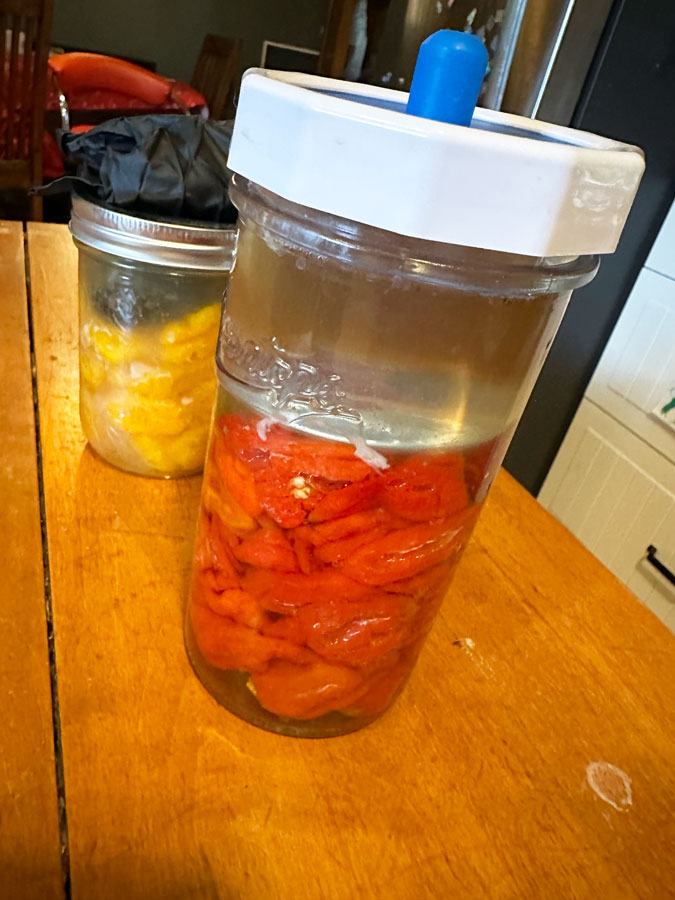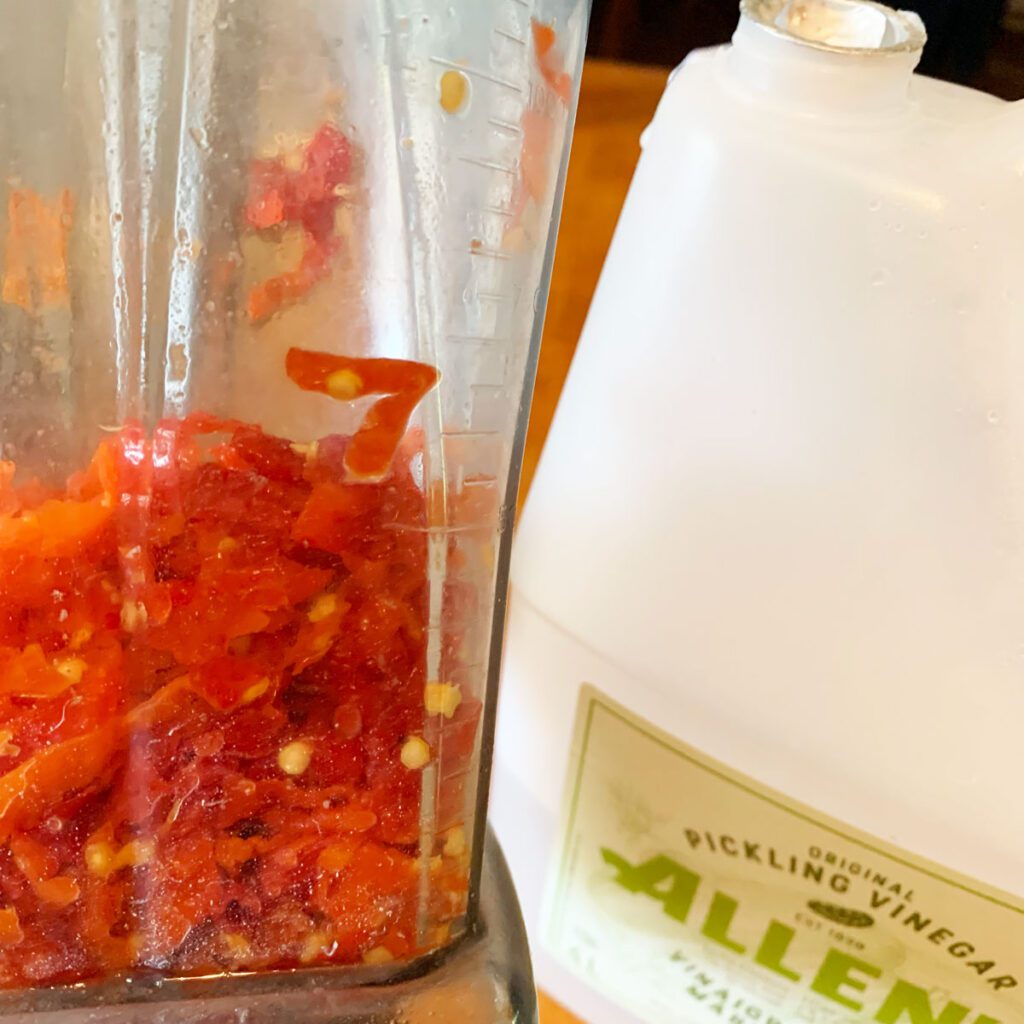Making Fermented Hot Sauce

How To Make Fermented Hot Pepper Sauce
Making Fermented Hot Sauce | Erik Biksa |
Above: 2 to 3 minute video, making fermented hot sauce, how to step by step.
Making fermented hot sauce is a great way to preserve and enjoy the qualities of your favorite hot peppers year round. The process is simple, inexpensive and doesn’t take a lot of work; just a matter of sticking to some fundamentals. Typically fermented hot sauce will have a long shelf life, longer than other preservation methods, while retaining more flavor and scoville units versus “cooked” sauces that can diminish some of these qualities.
Additionally, fermentation may create health benefits to foods because microbes are involved in the process, and the by-products they create can have a range of healthy benefits.
How Does Fermentation Preserve Foods?
In terms of making fermented hot sauce, think of wine–bottles of wine can be stored for decades at cooler temperatures while not requiring refrigeration. While the alcohol content is part of the magic of preservation here, it’s not entirely different.
In the case of hot sauce, microbes are breaking down the fresh components of the hot chilies, ie Dragons Breath, Carolina Reapers, Habaneros, Scorpion Peppers, etc in a salty brine. The byproducts create an acidic quality which in turn, preserves the remaining tasty materials.
As long as the pH of the fermented food is 4.6 or lower it is safe for human consumption and can have a long shelf life when stored in airtight glass bottles or jars. Kept refrigerated fermented hot sauce can last for a year or longer with very little decline in qualities like scoville units (heat).
Health Benefits of Fermented Foods
From a scientific standpoint, here is a quick snippet of a research paper available from the National Library of Medicine:
“Compounds known as biologically active peptides, which are produced by the bacteria responsible for fermentation, are also well known for their health benefits.
Among these peptides, conjugated linoleic acids (CLA) have a blood pressure lowering effect, exopolysaccharides exhibit prebiotic properties, bacteriocins show anti-microbial effects, sphingolipids have anti-carcinogenic and anti-microbial properties, and bioactive peptides exhibit anti-oxidant, anti-microbial, opioid antagonist, anti-allergenic, and blood pressure lowering effects.
As a result, fermented foods provide many health benefits such as anti-oxidant, anti-microbial, anti-fungal, anti-inflammatory, anti-diabetic and anti-atherosclerotic activity. “
Making Fermented Hot Sauce, How To Step By Step
- Use the highest quality fresh hot peppers available to you. Better yet, grow your own. Fermentation can preserve the qualities, not enhance them. Ensure that the fruits are clean, free of moulds, pests, etc. Freshly picked and vine ripened is always best. Some people like to add fresh garlic, onion or even fruit to the process for combined flavors.
- Materials you will need are large quart sized canning jars, fermentation lock or easy to buy from the internet fermentation jar kits, kosher salt (non iodized), filtered water, pickling vinegar, a food processor, glass bottles with plastic lids (metal will corrode), rubber gloves, eye wear and a large cooking pot.
- Use a large cooking pot with a canning rack to sterilize your jars, bottles, lids, fermentation locks, etc as you would for pickling or canning—don’t boil or heat the fruits though! Avoiding contamination is important; keep your working area and materials clean.
- With gloves and eye wear, remove any stem material from the peppers, just slice off the very top of the fruit with a kitchen knife. Some people remove the seeds–we retain them; they get crushed in the food processor later on and add heat. Best to do this in a well ventilated area–the fumes can be intense!
- Loosely pack the fruits into your fermentation jar, leaving room from the top for a glass or stone weight at the top that will serve to keep the fruits submerged in the brine. Some people slice the fruits; we find there isn’t a need, the fermentation process and food processor do all the work.
- Add 2 TBSPs Kosher salt to a quart of boiled water that has cooled slightly to make your brine. Make sure the salt is completely dissolved. Pour into the jar with the hot peppers until they are covered in the brine. Add a glass weight or sterile stone, ensuring that all the fruits are submerged below the brine solution (very important)
- Cover with a lid that will allow gas to escape, ie a fermentation lock like for brewing or a specialty fermentation lid. A nitrile glove over the jar works too–poke a couple pin holes in the finger tips so gas can escape.
- Place jar in a warm dark place, like a cupboard above the fridge. You want the conditions to remain steady and consistent. Typically, the process will occur for a minimum of two weeks–you’ll see bubbles rising to the top periodically once the fermentation process becomes active. Four weeks is usually ideal.
- Once fermented, drain the brine (a sieve is handy here) and add the fermented fruits to the food processor. Add a small amount of pickling vinegar and start up the food processor. CAUTION the fumes can be VERY Intense. An open window is a must and consider a respirator; for real.Keep adding pickling vinegar until you achieve a desired consistency, ie flowable but not watery.
- Pour into bottles carefully, wipe clean, secure lids and refrigerate—your fermented hot sauce is ready to enjoy!
The post Making Fermented Hot Sauce appeared first on GROZINE.



